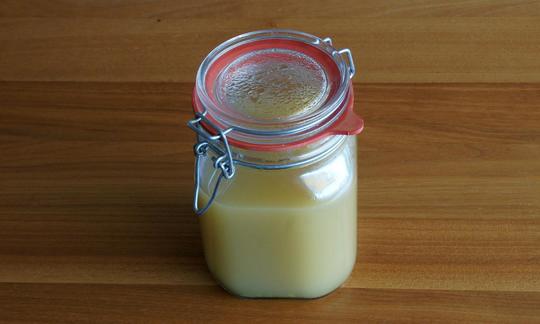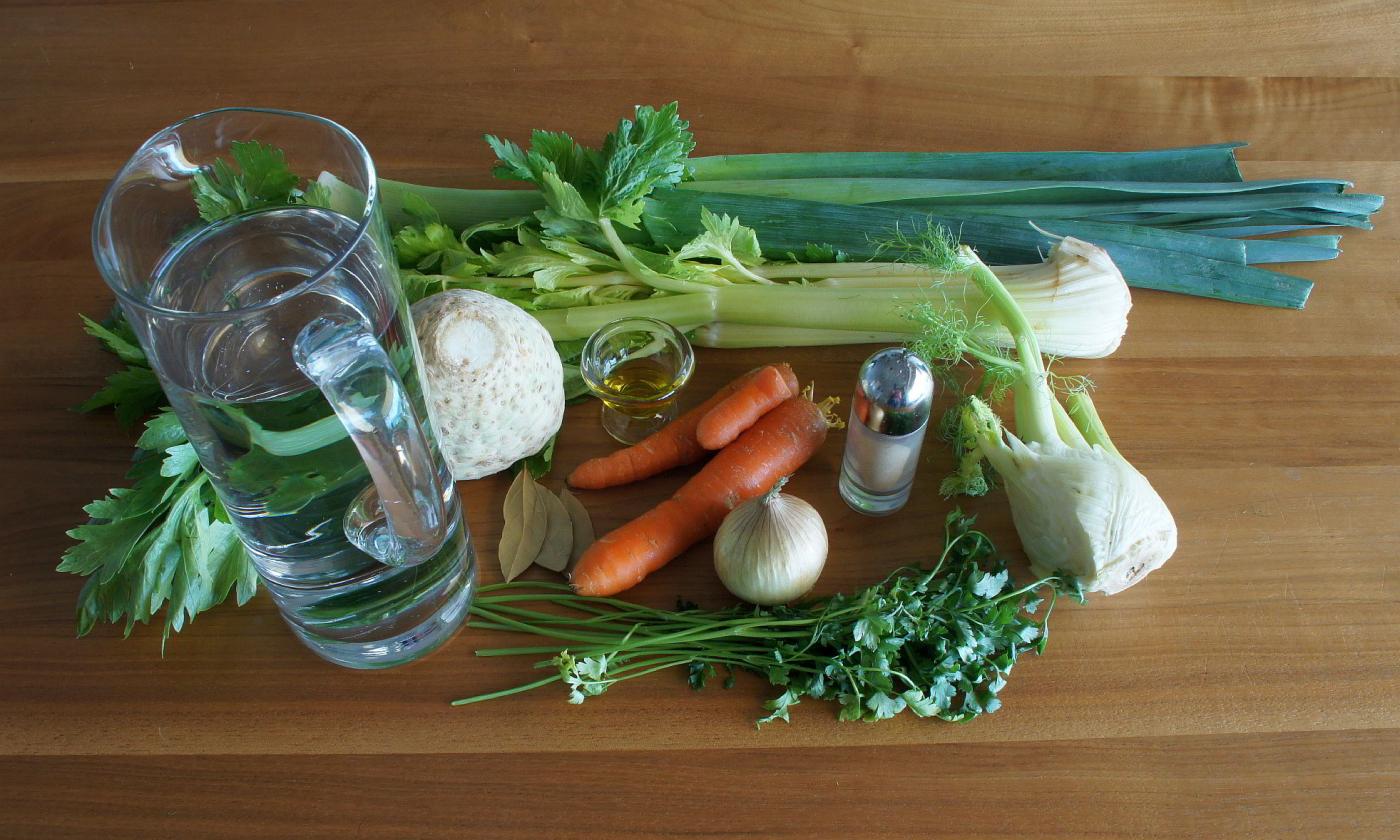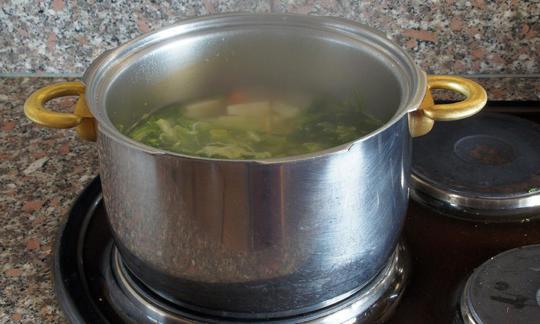Making Vegan Stock with Celery, Leeks, Fennel, and Carrots
vegan
Ingredients (for servings, )
| For the vegetable base | |
|---|---|
| 1 | Onions, raw (organic?) (3.9 oz) |
| 5 ½ oz | Celeriac, raw (organic?) |
| 5 ½ oz | Leek, raw (organic?) |
| 5 ½ oz | Celery (bleached celery), raw (organic?) |
| 5 ½ oz | Carrots (carrots), raw (organic?) |
| 3 ½ oz | Fennel (bulbs, raw, organic?) |
| 1 tbsp | Rapeseed oil (canola, HOLL oil, kernel oil), cold pressed?, organic? (0.49 oz) |
| For seasoning and canning | |
| 2 liter | Drinking water, raw (organic?) (70 oz) |
| 1 bunch | Parsley, fresh, raw (leaf parsley, parsley) (1.1 oz) |
| 3 leaves | Bay laurel (raw? organic?) (0.02 oz) |
| ⅛ oz | Black pepper (organic?, raw?) |
Equipment
- saucepan or pressure cooker
- vegetable peeler
- stove
Type of preparation
- cook
- sieve
- sweat
- can (bottle)
- sauté
- remove the skin
- peel
Preparation
For the vegetable base
Peel the onion and celery root. Clean the leeks, cut in half lengthwise, and wash. Clean and coarsely chop the celery stalks, carrots, and fennel.The onions don’t need to be completely peeled before sautéing — just make sure to remove the outermost layer.
Heat the canola oil in a large saucepan. Briefly sweat the onion and then sauté all of the ingredients on medium heat. The ingredients should only take on a little color here.
For seasoning and canning
Pour the tap water on top so that the vegetables are covered with water and bring to a boil. Then let simmer for about 45 minutes.Add the herbs and spices and let boil down an additional 45 minutes.
A relatively low temperature can be used for this step. In contrast to normal “cooking,” you shouldn’t see any bubbles forming on the surface.
Pass the vegetable stock through a fine sieve into a saucepan. Press the vegetables down lightly and then transfer to a separate bowl.
You can still use the vegetables, for example, by serving as a side dish.
While still hot, pour the vegan stock into clean, ideally sterilized, jars, let cool, and then refrigerate or use immediately.
|
Nutritional Information per person
Convert per 100g
|
2000 kcal | |
|---|---|---|
| Energy | 114 kcal | 5.7% |
| Fat/Lipids | 4.0 g | 5.8% |
| Saturated Fats | 0.39 g | 1.9% |
| Carbohydrates (inc.dietary fiber) | 19 g | 6.9% |
| Sugars | 6.6 g | 7.3% |
| Fiber | 4.7 g | 18.6% |
| Protein/Albumin | 2.6 g | 5.3% |
| Cooking Salt (Na:139.3 mg) | 354 mg | 14.7% |
| Essential micronutrients with the highest proportions | per person | 2000 kcal | |
|---|---|---|---|
| Vit | Vitamin K | 102 µg | 136.0% |
| Vit | Vitamin A, as RAE | 418 µg | 52.0% |
| Vit | Folate, as the active form of folic acid (née vitamin B9 and | 71 µg | 36.0% |
| Vit | Vitamin C (ascorbic acid) | 26 mg | 32.0% |
| Elem | Potassium, K | 590 mg | 30.0% |
| Min | Manganese, Mn | 0.50 mg | 25.0% |
| Min | Copper, Cu | 0.20 mg | 20.0% |
| Vit | Vitamin B6 (pyridoxine) | 0.28 mg | 20.0% |
| Fat | Alpha-Linolenic acid; ALA; 18:3 omega-3 | 0.36 g | 18.0% |
| Sodium, Na | 139 mg | 17.0% | |
Detailed Nutritional Information per Person for this Recipe
The majority of the nutritional information comes from the USDA (US Department of Agriculture). This means that the information for natural products is often incomplete or only given within broader categories, whereas in most cases products made from these have more complete information displayed.
If we take flaxseed, for example, the important essential amino acid ALA (omega-3) is only included in an overarching category whereas for flaxseed oil ALA is listed specifically. In time, we will be able to change this, but it will require a lot of work. An “i” appears behind ingredients that have been adjusted and an explanation appears when you hover over this symbol.
For Erb Muesli, the original calculations resulted in 48 % of the daily requirement of ALA — but with the correction, we see that the muesli actually covers >100 % of the necessary recommendation for the omega-3 fatty acid ALA. Our goal is to eventually be able to compare the nutritional value of our recipes with those that are used in conventional western lifestyles.
| Essential fatty acids | per person | 2000 kcal |
|---|---|---|
| Alpha-Linolenic acid; ALA; 18:3 omega-3 | 0.36 g | 18.0% |
| Linoleic acid; LA; 18:2 omega-6 | 0.86 g | 9.0% |
| Essential amino acids | per person | 2000 kcal |
|---|---|---|
| Threonine (Thr, T) | 0.12 g | 13.0% |
| Tryptophan (Trp, W) | 0.02 g | 8.0% |
| Isoleucine (Ile, I) | 0.07 g | 6.0% |
| Lysine (Lys, K) | 0.10 g | 6.0% |
| Leucine (Leu, L) | 0.11 g | 5.0% |
| Phenylalanine (Phe, F) | 0.07 g | 5.0% |
| Valine (Val, V) | 0.08 g | 5.0% |
| Methionine (Met, M) | 0.02 g | 2.0% |
| Vitamins | per person | 2000 kcal |
|---|---|---|
| Vitamin K | 102 µg | 136.0% |
| Vitamin A, as RAE | 418 µg | 52.0% |
| Folate, as the active form of folic acid (née vitamin B9 and | 71 µg | 36.0% |
| Vitamin C (ascorbic acid) | 26 mg | 32.0% |
| Vitamin B6 (pyridoxine) | 0.28 mg | 20.0% |
| Vitamin E, as a-TEs | 1.7 mg | 14.0% |
| Thiamine (vitamin B1) | 0.10 mg | 9.0% |
| Niacin (née vitamin B3) | 1.2 mg | 8.0% |
| Pantothenic acid (vitamin B5) | 0.51 mg | 8.0% |
| Riboflavin (vitamin B2) | 0.10 mg | 7.0% |
| Biotin (ex vitamin B7, H) | 3.0 µg | 6.0% |
| Essential macroelements (macronutrients) | per person | 2000 kcal |
|---|---|---|
| Potassium, K | 590 mg | 30.0% |
| Sodium, Na | 139 mg | 17.0% |
| Phosphorus, P | 104 mg | 15.0% |
| Calcium, Ca | 113 mg | 14.0% |
| Magnesium, Mg | 43 mg | 12.0% |
| Essential trace elements (micronutrients) | per person | 2000 kcal |
|---|---|---|
| Manganese, Mn | 0.50 mg | 25.0% |
| Copper, Cu | 0.20 mg | 20.0% |
| Iron, Fe | 2.0 mg | 15.0% |
| Fluorine, F | 359 µg | 10.0% |
| Zinc, Zn | 0.54 mg | 5.0% |
| Selenium, Se | 1.2 µg | 2.0% |
| Iod, I (Jod, J) | 1.8 µg | 1.0% |
In contrast to broth, stock is not a ready-to-eat dish. This vegan stock made with celery, leeks, fennel, and carrots is easy to make and is a good base to use for soup.
Differences between broth and stock: In cooking, there are several differences between broth and stock. Broth can be used as an ingredient or served as a dish on its own whereas stock has been boiled down, concentrated, and isn’t salted and is therefore only used as an ingredient for other recipes.
Boiling down: You will end up with more or less stock, and more highly or less concentrated stock, depending on how long you boil it down. With a more highly concentrated stock, as is the case with this recipe, smaller amounts are required to season other dishes.
Estimated yield: Although it first seems that large amounts of fluid and ingredients are used here, a recipe to serve 4 people will in the end make about 1 to 1.5 liters. However, this amount depends on the temperature the burner is set to, the time the soup is boiled down, and the size of the pot. If you only plan to use part of the stock immediately, this is an estimated yield you can use to plan the number of containers you will need for canning.
Quick version: If you want to prepare the stock quickly, you can use a pressure cooker. Cook the stock for about 20 minutes, add the herbs and spices, and then let simmer for an additional 15 minutes.
Buying prepared stock: Stock is sold in most well-stocked supermarkets, usually in jars or Tetra Pak cartons. However, commercially sold stocks often contain salt. If this is the case, you should make sure to add less additional salt.
Less work with organic vegetables: If you use only organic vegetables to make the stock, you don’t have to peel them first. And this adds extra flavor to the stock.
Using vegetable scraps: Vegetable scraps can also be used to make stock and give it a stronger flavor.
Storage: If the stock is poured into clean containers, ideally sterilized with hot water, it can be stored for about 2 weeks in the refrigerator or 3 months in the freezer.
Varying the ingredients: You can ultimately use any type of vegetables, including vegetable scraps, to make a stock. And you might like to add additional herbs and spices such as cloves, allspice, thyme, or garlic.
Serving the leftover vegetables as a side: When the stock is finished, there will be a bowl of leftover vegetables and herbs. Instead of throwing these away, you can use them, for example, to make a quinoa salad. If you use a little of the stock to cook the quinoa, this will bring out the flavor of the vegetables.












